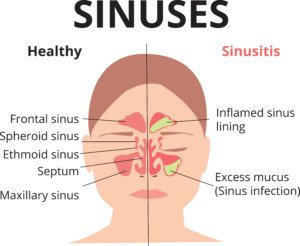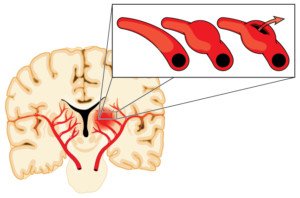
A most severe headache can be caused by a ruptured aneurysm as well as from sinusitis, particularly the sphenoid type.
A ruptured aneurysm, and sinusitis, are unrelated medical conditions, though a person by sheer coincidence can suffer from both maladies at the same time.
A ruptured aneurysm will almost always cause a horrible headache.
But the “worst headache of your life” can also result from sphenoid sinusitis.
Does the leaking/ruptured aneurysm headache differ from one caused by sinusitis?
“An acute infection can cause a debilitating headache on the top of the head,” says Dr. Stacey Silvers, MD, of Madison ENT & Facial Plastic Surgery in NYC, who is board certified in otolaryngology; one of her specialties is sinus surgery.
This is the typical location of the sinusitis pain.

Shutterstock/Ekaterina Siubarova
Depending on the sinuses that are affected, the pain can also be over the cheeks, between the eyes and over the forehead.
Dr. Silvers continues, “Patients have been admitted to the emergency room and often observed in the hospital for testing to rule out an aneurysm” that has ruptured.

Depiction of an aneurysm. Shutterstock/Blamb
A head pain arising from a burst aneurysm is often described as “thunderclap,” and is usually sudden in onset.
I say usually, because a slowly leaking aneurysm can also cause a less severe headache.
“Patients will have an MRI and MRA, and while (ruptured) aneurysm is often ruled out, the only finding on the MRI may be inflammation of one or both of the sphenoid sinuses,” says Dr. Silvers.
So one thing to keep in mind, regarding a ruptured aneurysm headache, is that it is almost always sudden, hence the term “thunderclap.”
However, how often is a headache the only symptom of a ruptured or leaking aneurysm?
In the case of a ruptured aneurysm, the headache (which is typically of alarming proportions) may be “associated with change in mental status, loss of consciousness, seizures or other focal neurological deficits,” depending on location, explains Carol Redillas, MD, founder of Crescent City Headache and Neurology Center.
Depending on a leaking aneurysm’s location, a condition called ptosis (drooping eyelids) will occur. Sinusitis can also cause eyelid ptosis.

Ptosis: drooping eyelid
Another telltale sign of a possible (note: possible, not definite) ruptured aneurysm is if the headache suddenly slams you in the midst of physical exertion (especially while holding one’s breath).
But a physical exertion headache isn’t necessarily a ruptured aneurysm. Another condition of the eye, called miosis, can result from a leaking aneurysm.
Sinusitis will not cause this, however. An aneurysm will typically leak before it ruptures, says Dr. Redillas.
Dr. Redillas says that a ruptured aneurysm is suspected when a headache is sudden, severe, and unprecedented, and especially if it’s associated with ptosis, miosis and/or neck stiffness, along with cognitive impairment.
This life-threatening condition needs to be immediately ruled out by medical tests when a thunderclap headache occurs.
“If an MRA or a 4 vessel angiogram is negative for an aneurysm and the same headache recurs,” says Dr. Redillas, “then you can be rest assured that your headache is most likely benign.”
A telltale sign (but not always) of the sinusitis headache is that it moves with you as you change position; or, to put it another way, it worsens when you lean or stoop over, squat, do jumping jacks or even milder aerobics, trot down some steps, etc.
It may also be accompanied by nasal congestion or fever, but sometimes the pain stands alone.
Do Not Attempt to Self-Diagnose Headaches
… but do keep a detailed journal of when they occur, any precipitating factors, character of the pain, caliber of the pain, location, etc., so that you can present this information to a doctor.
In the event of sinusitis, Dr. Silvers explains that decongestants and antibiotics are used to relieve the symptoms.
She says, “When the medical management fails, it may be necessary to open the door of the sinus through endoscopes to improve the natural opening in the sinus, culture the sinus drainage, and flush out the infection.”











































